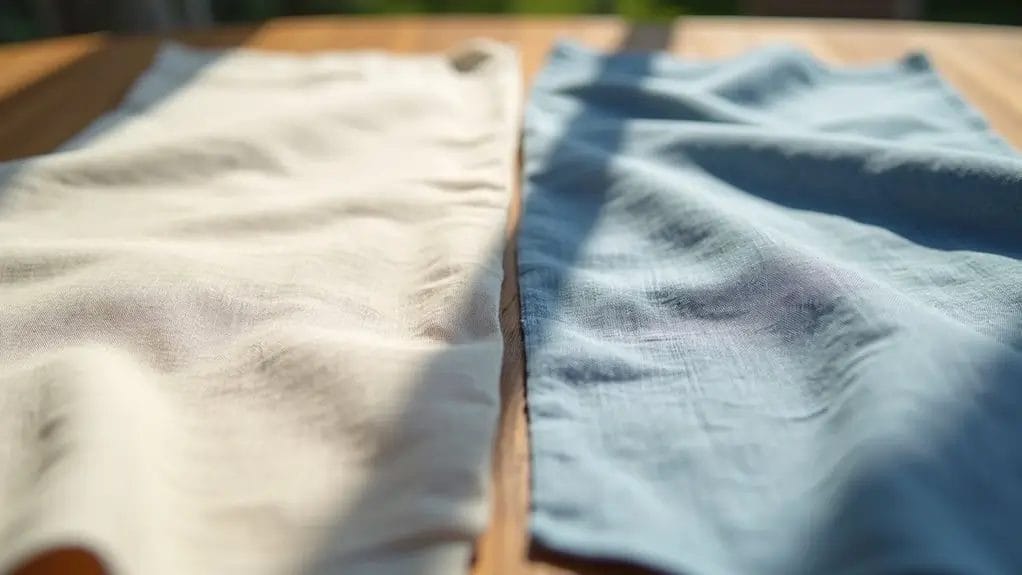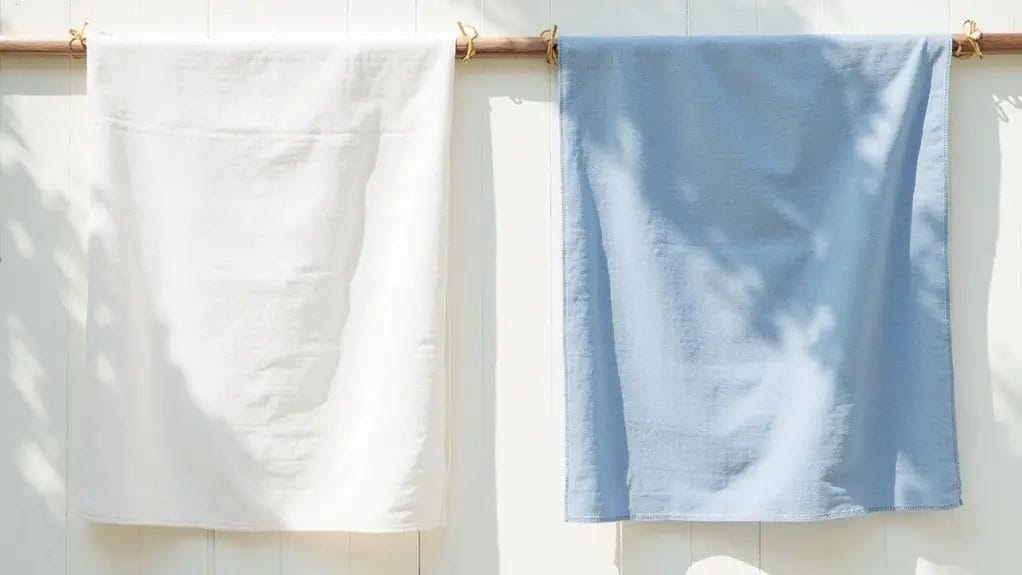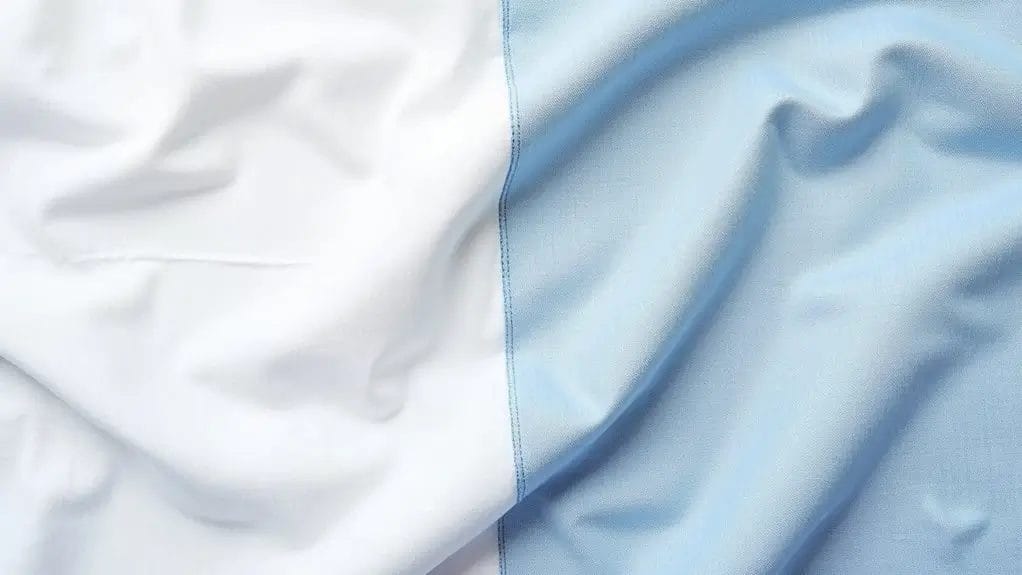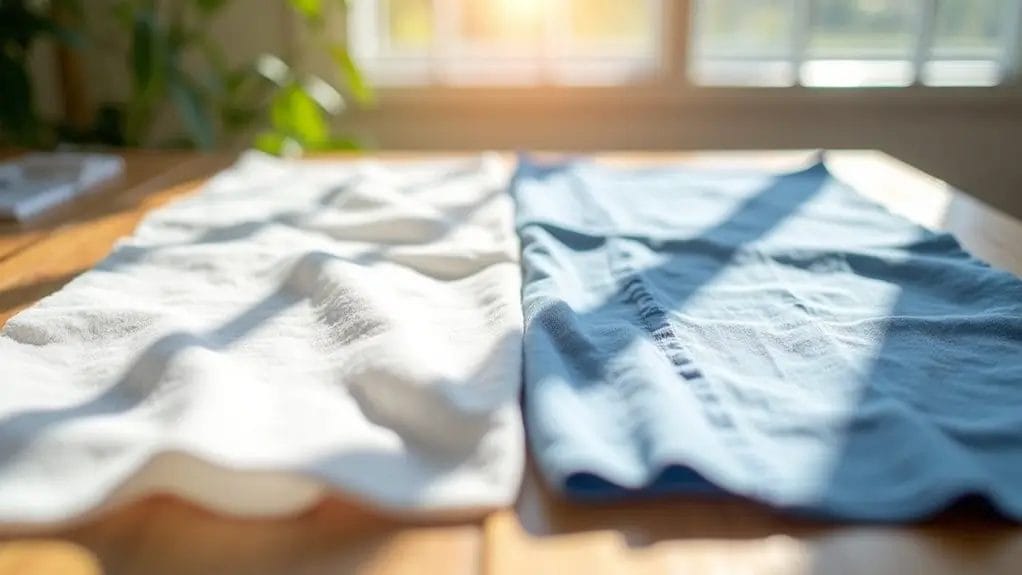You've likely encountered both linen and chambray in your summer wardrobe selections, but understanding their fundamental differences is essential for ideal warm-weather comfort. While linen's hollow-fiber structure creates natural ventilation channels, chambray's tight plain weave offers a different approach to heat management. These distinct textile constructions directly impact your body's temperature regulation and moisture control during those sweltering summer days. Let's examine how these fabrics' unique properties affect your seasonal comfort choices.
Key Takeaways
- Linen's hollow fiber structure provides superior breathability and can absorb 35% of its weight in moisture, making it excellent for hot weather.
- Chambray offers decent airflow but is denser than linen, resulting in less effective heat dissipation during peak summer temperatures.
- Linen naturally wicks moisture and has antimicrobial properties, while chambray provides consistent comfort with less moisture-management capability.
- Both fabrics are lightweight, but linen becomes softer over time and excels in high-humidity environments despite its wrinkle-prone nature.
- Linen is better suited for formal summer occasions and extreme heat, while chambray works best for casual warm-weather activities.
Understanding Fabric Types

Linen, a cellulosic fiber derived from the flax plant, features a distinctive node structure that creates its characteristic texture and high moisture-wicking capabilities.
Chambray's unique construction consists of a colored warp yarn interwoven with a white weft yarn in a plain weave, creating a fabric that's technically different from denim despite their similar appearance.
While both fabrics serve as popular summer textiles, linen's natural hollow fibers and chambray's balanced thread count structure offer distinct characteristics that influence their performance in warm weather conditions.
What is Linen?
The ancient Egyptians pioneered one of history's most enduring textile innovations - a natural fiber derived from the flax plant (Linum usitatissimum).
You'll find that linen fibers are composed of long, hollow cellulose strands that give the fabric its distinctive characteristics. These natural fibers undergo a process called retting, where enzymes break down the pectin binding the fibers to the stalk.
The resulting textile offers exceptional breathability due to its porous structure, though it's prone to wrinkle formation. Linen's unique molecular arrangement creates a fabric that's 30% stronger when wet than dry, with superior moisture-wicking properties that make it ideal for warm weather.
What is Chambray?
Chambray emerged in the mid-1500s from Cambrai, France, as a lightweight plain weave fabric constructed with a colored warp yarn and white weft yarn.
While it's often confused with denim, you'll notice chambray has a distinct 1:1 weave ratio, creating a smoother surface texture.
The fabric's unique construction uses finer yarns than denim, typically incorporating a colored warp thread interwoven with white weft threads.
You'll find chambray most commonly made from cotton, though some textile manufacturers blend it with silk or linen fibers.
The result is a breathable, versatile fabric that's lighter than denim while maintaining durability.
Comparing Linen and Chambray
When comparing these two distinct textile structures, you'll find fundamental differences in their fiber composition and weave construction.
Both linen and chambray offer excellent summer-wear qualities, but they differ markedly in their properties.
- Linen uses natural flax fibers in a plain weave, while chambray combines dyed warp and white weft cotton yarns.
- Linen delivers superior breathability through its hollow fiber structure, whereas chambray provides moderate air circulation.
- Chambray maintains a softer, more flexible drape compared to linen's crisp texture.
- Linen offers exceptional durability and becomes softer over time.
- Both fabrics are lightweight, but chambray provides more consistent comfort without linen's initial stiffness.
Summer Comfort and Breathability

Linen's natural cellulose fibers feature a hollow core structure that creates multiple air channels, allowing your skin to breathe through the fabric while wicking moisture away from your body.
Chambray's tightly woven cotton construction, while still breathable, offers less ventilation due to its denser fiber arrangement and plain weave pattern.
You'll find that linen's loose basket weave and natural fiber properties provide superior air circulation in hot weather, though both fabrics remain viable summer options depending on your specific comfort needs.
Breathability of Linen
Natural fiber enthusiasts prize linen for its exceptional breathability, which stems from the hollow core structure of flax fibers and their loose molecular arrangement.
You'll experience superior ventilation in higher temperatures due to linen's unique properties:
- Microscopic channels within fibers actively wick moisture away from your skin
- Natural fiber structure allows up to 35% of its weight in moisture before feeling damp
- Open-weave construction creates excellent air circulation pathways
- Hollow fiber cores facilitate rapid heat dissipation to help you stay cool
- Porous surface texture increases the fabric's total breathable surface area
This inherent breathability makes linen ideal for summer wear.
Breathability of Chambray
Chambray's breathability characteristics differ considerably from linen while still offering commendable warm-weather performance. The fabric's unique weave structure, featuring colored warp and white weft yarns, creates a lightweight cotton composition that's inherently breathable.
You'll find that chambray's plain weave construction allows air to flow freely between the fibers, making it comfortable in hot weather.
While not as airy as linen, chambray's tightly woven cotton threads create a more consistent breathability pattern. The fabric's moisture-wicking properties help regulate your body temperature, and its balanced structure provides reliable ventilation without compromising durability or appearance in summer conditions.
Choosing the Right Fabric for Hot Weather
The selection of an ideal summer fabric hinges on understanding the interplay between fiber composition, weave structure, and moisture management properties.
When choosing suitable material for hot weather, consider these critical factors:
- Natural fibers like linen and cotton regulate heat transfer more effectively than synthetics
- Open weave structures enhance air circulation and reduce wear discomfort
- Moisture-wicking capabilities determine how quickly perspiration evaporates
- Fabric weight impacts thermal resistance and overall comfort
- Surface texture affects skin contact and air pocket formation
Your choice between linen and chambray should prioritize these performance characteristics to optimize comfort during peak summer temperatures.
Style and Durability

Linen's inherent fiber properties create structured silhouettes ideal for tailored resort wear and relaxed separates, while chambray's balanced weave structure produces a softer drape suited for casual workwear and contemporary streetwear.
You'll find linen's natural tensile strength superior for long-term garment integrity, though its tendency to wrinkle requires specific care protocols.
Chambray's tightly-woven cotton construction offers reliable durability against everyday wear, maintaining its shape through repeated laundering cycles without linen's characteristic creasing patterns.
Fashion Styles with Linen
When designing your summer wardrobe, versatile linen garments offer exceptional breathability and a naturally crisp structure that maintains its shape throughout wear.
You'll find linen's adaptable nature perfect for creating a polished look across multiple style applications.
- Tailored linen suits with structured shoulders and natural drape for professional settings
- Relaxed-fit linen shirts with rolled sleeves and open collars for casual elegance
- Wide-leg linen trousers featuring precise pleating and cuffed hems
- Minimalist linen blazers with notched lapels and patch pockets
- A-line linen dresses with dart shaping and bias-cut panels
These garment options showcase linen's versatility while maintaining its signature textural appeal.
Fashion Styles with Chambray
Durable chambray fabric delivers a versatile denim-like aesthetic while maintaining a lighter weight and softer drape than traditional denim.
You'll find this fabric excels in casual button-down shirts, where its balanced weave structure creates a refined yet relaxed appearance. The cotton fibers' plain weave construction allows for excellent breathability and movement.
Pair your chambray shirt with white chinos for a crisp summer look, or layer it under a blazer for business casual settings. The fabric's jean-like appearance means you can style it similarly to denim while enjoying superior comfort.
Chambray clothing adapts well to both structured and unstructured garment designs, from fitted dresses to flowing skirts.
Durability Comparison: Linen vs Chambray
Both linen and chambray offer distinct durability profiles that affect their performance in summer garments. Their unique fiber compositions determine their long-lasting properties and quality characteristics.
- Linen's strong flax fibers create a durable fabric that becomes softer with each wash while maintaining structural integrity.
- Chambray's tight cotton weave offers sustainable wear resistance but may show more signs of fading over time.
- You'll find linen delivers superior tensile strength, making it more resistant to tearing.
- Chambray's balanced weave structure provides timeless durability for everyday wear.
- While linen can last decades with proper care, chambray typically maintains its quality for 3-5 years of regular use.
Making the Right Choice

Consider your specific needs when choosing between linen's natural bast fibers and chambray's cotton twill construction for summer wear.
You'll want to select linen when maximum breathability and moisture-wicking properties are essential, particularly for formal occasions or extended outdoor activities in high humidity.
Opt for chambray when you need a more structured fabric that resists wrinkling and maintains its shape throughout daily wear, especially for casual or business-casual settings where consistent appearance matters.
When to Choose Linen
When selecting a summer fabric, linen becomes the ideal choice if you're prioritizing breathability and moisture management in hot, humid conditions.
Choose linen when you need the best performance in warm climates, as its hollow fiber structure excels at temperature regulation.
- A fine linen shirt offers superior moisture-wicking through rapid evaporation
- Linen's natural pectin content provides antimicrobial properties
- The fiber's inherent stiffness creates airspace between fabric and skin
- Linen becomes softer and more comfortable with each wash
- The fabric's high tensile strength guarantees durability in repeated wear
When to Choose Chambray
Selecting chambray proves advantageous if you're seeking a lightweight cotton fabric that combines casual appeal with structural versatility.
Its unique plain weave construction makes it an ideal alternative to denim, while maintaining better breathability.
Choose chambray when you need a fabric that can blend seamlessly between casual and semi-formal settings.
The difference lies in its balanced weave structure, which creates a smoother surface than linen.
You'll find chambray particularly suitable for structured garments like button-down shirts, dresses, and lightweight blazers where you want to maintain a crisp silhouette without the heaviness of traditional cotton twills.
Frequently Asked Questions
Can Linen and Chambray Fabrics Be Blended Together in One Garment?
You'll find that linen and chambray fibers can be blended during yarn production, creating a hybrid fabric that combines linen's breathability with chambray's cotton durability for a balanced textile structure.
Are There Specific Washing Instructions for Maintaining the Color of Chambray?
You'll need to wash chambray in cold water, using color-safe detergent. Turn garments inside-out, avoid harsh agitation, and don't over-dry. The indigo dye in warp yarns requires gentle care to prevent fading.
Which Fabric Shows Wrinkles More Prominently After Sitting for Long Periods?
You'll notice linen's cellulose fibers show more prominent creasing and wrinkles due to their rigid molecular structure. Chambray's tighter cotton weave and more flexible fibers help it maintain smoother appearance after prolonged sitting.
Do Linen and Chambray Fabrics Pill Differently Over Time?
You'll notice chambray's tight-woven cotton fibers are more prone to pilling through abrasion, while linen's longer, stronger bast fibers resist pilling due to their natural rigidity and longitudinal fiber structure.
Can Both Fabrics Be Effectively Used for Home Decorating Projects?
You'll find both fabrics suitable for decor projects. Linen's natural strength and textural weave work well for upholstery and drapery, while chambray's cotton warp-and-weft construction makes excellent throw pillows and tablecloths.
Conclusion
Selecting between linen's hollow-fiber structure and chambray's plain weave construction, you'll find linen's superior moisture-wicking properties make it your ideal summer choice. The natural cellulose fibers in linen create microscopic channels that facilitate rapid moisture transport and evaporation, while its open-weave architecture maximizes airflow. Though chambray's cotton composition offers reasonable breathability, it can't match linen's inherent thermoregulatory capabilities and moisture management performance.


0 comments